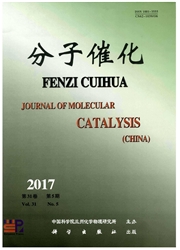

 中文摘要:
中文摘要:
以SnO2催化臭氧化降解高浓度糖蜜酒精废水为探针反应,研究SnO2催化臭氧氧化降解糖蜜酒精废水的活性,并采用吸附吡啶的红外光谱研究SnO2及金属氧化物改性的SnO2催化剂表面的酸性.催化剂吸附吡啶的红外光谱表明:吡啶分子在SnO2表面吸附时,形成六元环振动峰1449cm^-1,说明SnO2表面存在Lewis酸中心.掺入第二组分对SnO2进行酸性调变后,酸类型和酸中心发生了变化.CuO-SnO2催化剂表面仅存在L酸,NiO-SnO2,Fe2O3-SnO2及CoO—SnO2等的表面不仅存在L酸,还存在不同强度的B酸,且Fe2O3-SnO2与CoO-SnO2存在与SnO2不同的第二类L酸.水的存在使得NiO-SnO2,Fe2O3-SnO2及CoO—SnO2催化剂表面的L酸减弱,B酸强度增强;而CuO—SnO2表面出现了弱的B酸.将催化剂的酸类型与催化臭氧氧化活性进行关联,发现B酸的存在是造成催化剂活性降低的一个原因.
 英文摘要:
英文摘要:
Heterogeneous catalytic ozonation technology is a new type of ozone oxidation method, which can degrade the organic compounds that couldn't be oxidized or degraded by ozone alone at room temperature and normal pressure. SnO2 was prepared by precipitation method and mental oxides modified SnO2 catalysts were prepared by coprecipitation method. High concentration molasses fermentation wastewater degradation by SnO2 catalyzed ozonation was used as a probe reaction and IR spectra of pyridine adsorption on SnO2 and metal oxide modified SnO2 was studied to identify the surface acidity on catalysts. The IR spectra of pyridine adsorption on SnO2 showed, hexahydroxy ring vibration which was formed by pyridine complexes to SnO2 surface was showed at 1449 cm^-1 indicated that there were Lewis acid sites exist on SnO2 surface. Acid type and acid sites changed after other second metal oxides were added to SnO2. There is only Lewis acid site exist on CuO-SnO2 catalyst surface. There are not only Lewis acid sites but also different strength Br nsted acid sites exist on NiO-SnO2, Fe2O3-SnO2 and CoO-SnO2 surface, and a second kind Lewis acid sites, which was know from that of SnO2, was found on Fe2O3-SnO2 and CoO-SnO2 surface. The Lewis acid strength was weak and Brcnsted acid strength was enhanced on NiO-SnO2, Fe2O3-SnO2 and CoO-SnO2 while water exit, and at the same time weak BrФnsted acid was found on CuO-SnO2 surface. Compared the acid types on catalysts surface with the catalyzed ozonation activity, it was found that BrФnsted acid site existing was a reason of the catalytic activity decreasing.
 同期刊论文项目
同期刊论文项目
 同项目期刊论文
同项目期刊论文
 期刊信息
期刊信息
